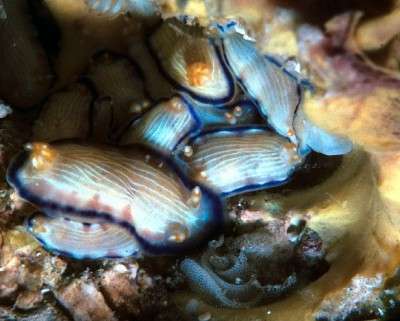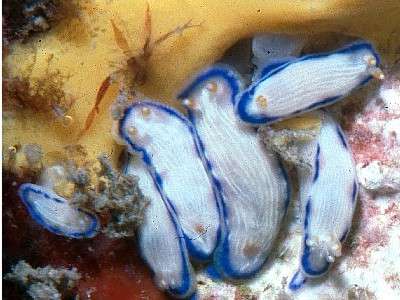Hypselodoris 'andersoni' from Hawaii
February 10, 2000
From: Scott Johnson


Since the Forum seems to be putting together a good collection of pictures of Hypselodoris species, I thought I'd add another. Attached is an animal I have called 'chromodorid 1' and 'Hypselodoris sp. 1' in a couple of papers in the Veliger. Hans Bertsch and I referred to it as "locust" in our Hawaiian Nudibranchs. Hans and Terry Gosliner finally named it in 1989 as Hypselodoris andersoni.
It's a species with strongly diurnal habits. During the day, it tends to be exposed in the open feeding on yellow sponge (Luffariella sp.), often gathering in groups of up to 30 or more to completely devour sponge colonies (hence the name "locust" -- in lower photo the white patch is bare rock grazed clean of sponge). At night, they crawl inside cavities in the sponge clumps or into holes in the reef to hide, often leaving their egg masses in those holes (bottom centre of upper photo).
While they always have dorsal, close set, white longitudinal lines, they vary in the extent of dorsal spotting and in the development of pink patches along the margins. From my records this species can get up to around 20mm in length.
Scott
johnson@kmr.ll.mit.edu
Johnson, S., 2000 (Feb 10) Hypselodoris 'andersoni' from Hawaii. [Message in] Sea Slug Forum. Australian Museum, Sydney. Available from http://www.seaslugforum.net/find/1856Dear Scott,
Thanks for the photos and information on this and the other lined chromodorids from Hawaii.
As I have discussed in a separate message, I think this species is the real Hypselodoris peasei.
Since I started looking at the chromodorids, I have been fascinated with the white-lined species from Hawaii as they seem to form another group of mimics on the edge of the Indo-West Pacific like the red-spotted group in southeastern Australia. I hope to be able to post the photos you have sent of the other Hawaiian species as soon as possible.
Bill Rudman.
Related messages
-
Re: Original description & identity of Hypselodoris peasei
From: Ron Velarde, February 12, 2000 -
Re: Identity of Hypselodoris peasei
From: Terry Gosliner, February 12, 2000 -
Original description & identity of Hypselodoris peasei
From: Bill Rudman, February 10, 2000
